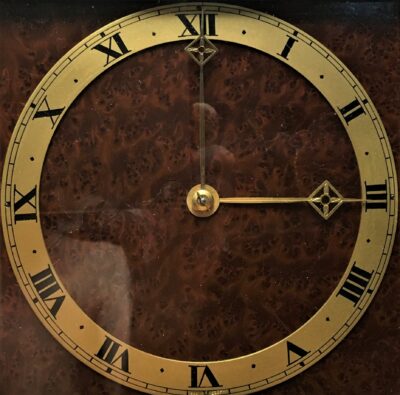Last Update: 09-23-2023 @ 04:57
How to Identify an Old Clock
- Once you have bought an old clock, you need to identify it. In the following, you will learn the identification process.
- The Identification Process:
- The Identification Sources
1.05.1 – The Clock Identification Process
The identification process’s first step is documenting your old clock by taking pictures of the case and its movement. The second step is to look closely at the clock itself, starting with the dial, then the marks on the case, the movement, the pendulum, and the key. Search for any clue about the make, the manufacturer’s name, the model, and the date. To help you better identify, I suggest some useful websites, books, and trademark lists. ⬆️
Document your clock with photos
The clock is the primary source of identification. Therefore, it is essential to take pictures of it from all angles, of the case’s writing marks and labels, large or small, and its movement. Use the macro function of the camera or phone for small details. Enlarge any name, acronym, trademark, on the dial, on the clock itself or inside, or on the movement. Preserve them. Handwriting, often initials and dates, is the work of the clockmakers who maintained or repaired the clock. Also, metal parts, especially the bezel, the rim of the dial, or even the door’s hinges, may have engraved inscriptions. These are often Patent numbers and dates, manufacturing places, etc. All these photographed elements will help you locate the clock in time and space.
Beware!
An old clock may have, during its life, been transformed. Someone may have replaced the movement with another of a different brand, the same for the pendulum or the winding key. Alteration of the case by changing the color, replacing, or adding decorative elements is also common. Sometimes clock sellers lend themselves to this game to get a better price, but in doing so, alter the value of an old clock by hiding the changes. The best guarantee that one gets from the authenticity of the brand is when you can cross several sources of data: the same mark on the dial, the case (label) or the movement (engravings), verification of the originality of the pendulum, and key, search for a clock similar or closer, in old catalogs, reference books, and specialized websites. ⬆️
In search of the name of the manufacturer or trademark
The following flowchart guides you through the exam of what is more apparent in a clock, the dial, to see if there is any manufacturer name on it.

The Dial
Look at the dial first. The chances are that you will find the name of the manufacturer or its trademark on the dial, either in print or in a unique acronym or trademark. If there is a brand name, you are lucky. If it is a graphic trademark, you need to consult trademarks lists (see below) to search for the manufacturer’s name. Some trademarks are straightforward to identify but could be tricky for others.
If there is no name or graphic mark on the dial, you need to inspect the case to see if there is any label with a manufacturer’s name. It could be a small sticker or a printed stamp on the outside of the case, sometimes on the back or underneath. It could be a large label inside the case or on the back door. In all cases, it is essential to preserve these labels and stickers. If you’re lucky, you will find a name or a trademark. ⬆️
The Movement
No name on the case; look at the movement. It could be your next chance to discover the manufacturer name of your clock. Search for a name, a trademark, or a dated patent number. Some clocks are made from parts coming from unknown sources. Some vendors of clocks buy their cases from a cabinetry shop. Then they add movements from a clockmaker, purchased in large quantities. The purpose is to sell the clocks at a low price in large stores. Usually, a well-known clock manufacturer doesn’t want its name associated with low-price clocks to avoid its own branded clocks’ cannibalization.
Therefore, your clock is unbranded if the case and the movement have no name or trademark. Your last chance at identifying the clock manufacturer is to look at the pendulum and key. ⬆️
The Pendulum
But beware, with the key, the pendulum is the element of an old clock that the owners often lose. Sometimes, previous owners have replaced the pendulum or the bob. So, it could be very hazardous to name a clock just by its pendulum, even more with the key. Usually, the pendulum, sometimes the key, will confirm a brand more than anything.
Let’s look at several types of pendulums. Some manufacturers had clocks with a typical pendulum, characteristic of their brand or bearing the trademark’s image. Here are some pendulums from old clocks, some with branding in the first illustration.


The Key
Don’t rely on the key to precisely identify a clock brand or date because many replacement keys are in circulation. Not all manufacturers had their names on the keys. So, it would be hazardous to brand the clock after the name or logo on the key. The key serves only to confirm other clues.
Finally, it is essential to know that a loose key on the winding pivots may not be original. A loose key, eventually, skins the winding pivot. Therefore, a tighter one must replace it. Here are a few examples of keys.
Manufacturers Keys
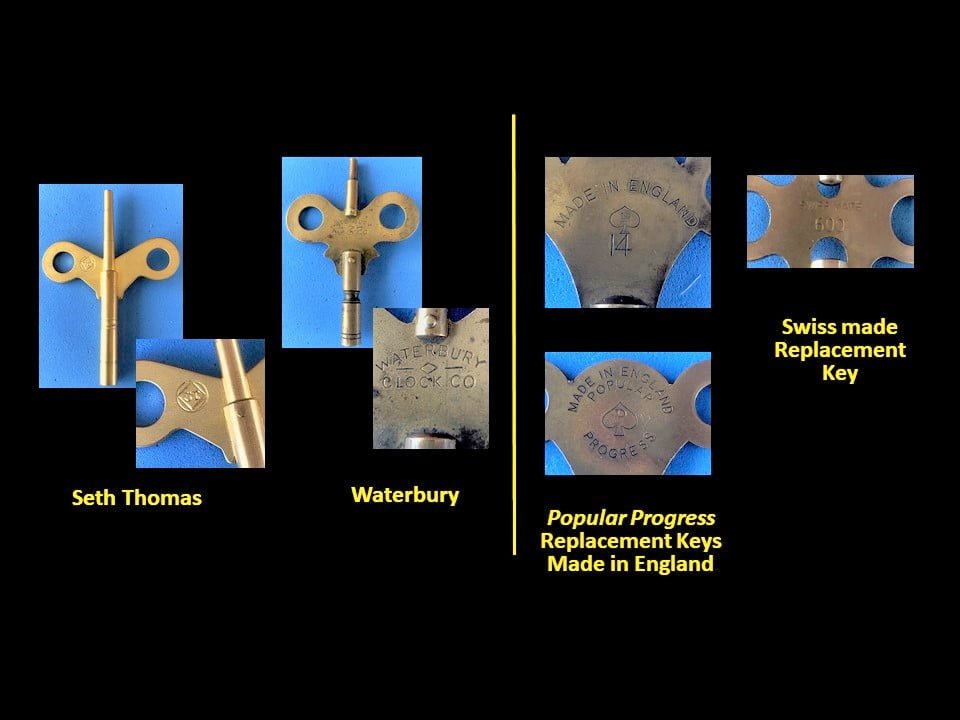
French and German Keys
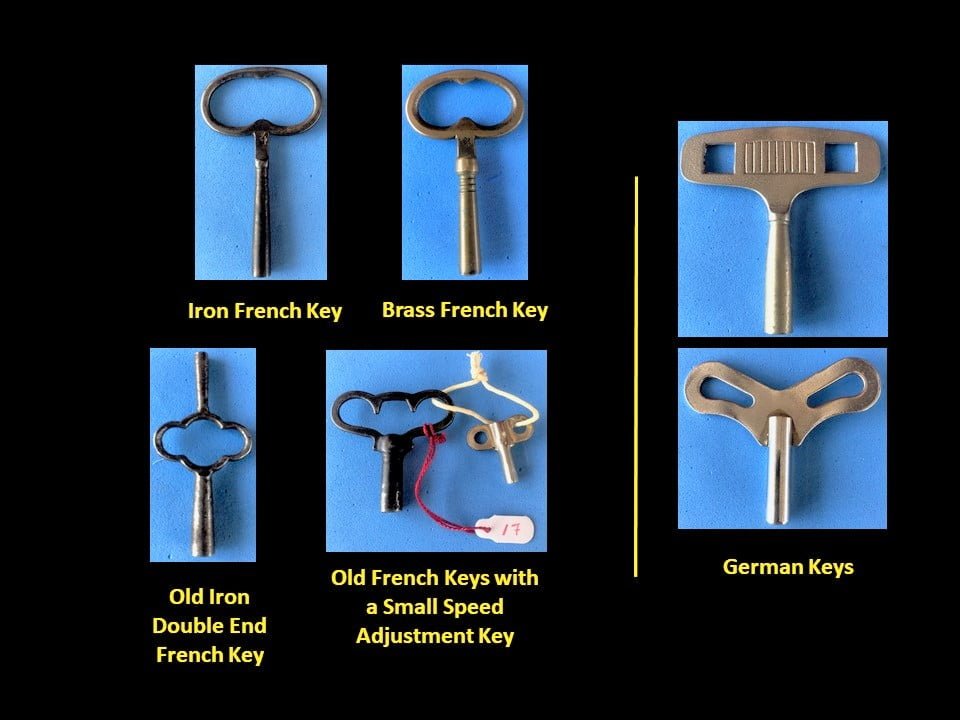
Specialized Keys


In Search of the Model
Identifying the model may be more challenging if you can identify the brand. Most of the time, if there is any, you will find the model’s name on a sticker or a label glued to the case or in the manufacturer catalog. Sometimes, it was only a number. It is, therefore, necessary to be patient. Consult old catalogs or records, specialized websites, and some specialists who have access to more references, such as the members of the NAWCC, or through my blog or contact. If you’re unable to find a model name, you must accept that several manufacturers did not bother to give model names to their clocks. ⬆️
In Search of the Year of Fabrication
Accept a certain elasticity in dating a clock. Indeed, the date is often not on the case or the label that may accompany it. It is more likely to be on the movement, but beware, the date is, most of the time, one of the patents. For example, an Ansonia whose patent date on the movement is 1892 does not mean that it is the manufacturing date. Ansonia used that movement for several years after obtaining the patent, and this, in several models. But it provides a reliable clue, and one can put an approximate date on the clock. Do not mistake advertising this Ansonia clock as having been manufactured in 1892. Mention instead that the clock is from the late 19th and early 20th century unless other sources allow you to set a more precise date. ⬆️
1.05.2 – The identification Sources
There are many sources to help you identify your clocks. Websites and books are the most common.
Websites
Websites like this one can be handy sources of information. Most are in English. This one is also in French. Be aware that you will need to invest time to search the web and a particular ability to find suitable sources of information by manipulating keywords with expertise. To make it easier for you, I suggest below some beneficial sites. ⬆️
Associations
- National Association of Watch and Clock Collectors, Inc. – NAWCC is the largest American association of antique clock collectors, with chapters in the United States and Canada. The site is available free of charge. But there is a membership fee. If you are skilled enough to write in English, I advise you to register for one of their free forums. You will be able to ask questions and comments to enthusiasts of well-versed antique clocks collectors. They may help you identify or repair your clocks. Click to reach the Encyclopedia. ⬆️
Clock Guides and Manufacturer List
- Antique clocks guide price – The site includes a lot of information for free use, but for details, you must subscribe. Don’t rely too much on the indicated values of the illustrated clocks. Most of the time, they do not represent the actual current value.
- Clock history – Excellent site for people interested in Westclox, Seth Thomas, and Telechron clocks.
- Collector’s Weekly – Clocks section: It’s an online magazine where you can find helpful information. It’s illustrated since it’s also a clock sale site. It includes some references to other interesting sites.
- Discover Clocks – Old clock collector’s site: many images, a blog, etc.
- U.K. and Irish Clock and Watchmakers (c 1600-c 1940): This British and Irish clock and watchmakers site includes a database of nearly 36,000 records. The site is now archived so that researchers can view the information held in the database for a daily charge.
- Wikipedia – List of Clock manufacturers: Includes a list of manufacturers from thirteen countries, some of which refer to a detailed article on this manufacturer’s history. ⬆️
Clock Museum Sites
- American Clock and Watch Museum – Situated in Bristol, Connecticut, the clock capital of the United States in the 19th century, the museum is small but worth the visit.
- Musée international d’horlogerie – Located at La Chaux-de-Fonds, Switzerland, the web site of this museum is multilingual.
- National Watch and Clock Museum – Located in Columbia, Pennsylvania, the National Association of Watch and Clock Collectors, Inc. museum contains over 12,000 clocks and watches from everywhere worldwide. It is an instructive visit!
- The Canadian Clock Museum – More than 3,500 Canadian clocks are on display. It is an essential source of information for Canadian-made clocks. The tour is worth the trip, even if it’s far away, almost two hours by car from Ottawa, Ontario. ⬆️
Print Documentation
There are many books on old clocks but few very recent works. Therefore, it is necessary to use public libraries often to borrow or buy used books from online sellers or bookshops. You must be careful in this area and look for the best prices. Some books can still be purchased new, although published in the 1990s or early 2000s.
I acquired most of the books mentioned in the Bibliography on eBay or Amazon, which often act as intermediaries for specialists in used books. In addition to books, there are reprints of old catalogs from some U.S. suppliers. Still, these catalogs, mostly yearly catalogs, do not represent the entire production of a manufacturer.
Besides, an American author-collector, Tran Duy Ly, has bothered to collate several manufacturers’ clock models through the catalogs over the years. Arlington Books is the complete reference and sale site for the Tran Duy Ly books. But you can find them on eBay and elsewhere, but again, compare the prices before ordering. ⬆️
Trademarks Sources
Finally, for the more curious, some manuals contain the trademarks of clock manufacturers. When their name is absent from the case or movement, but the acronym or a graphic trademark is present, documentation is often required to identify a clock’s brand successfully. There are some websites like Antique horology or Microlisk (in German). Still, nothing is better than a bible like “Clock and Watch Trademark Index of European Origin” for European clocks or the “United States Horological Trademark Index” for American clocks.
To give you examples of the most common trademarks, you will find next a gallery of several trademarks from several countries:
American Trademarks

French Trademarks

German Trademarks
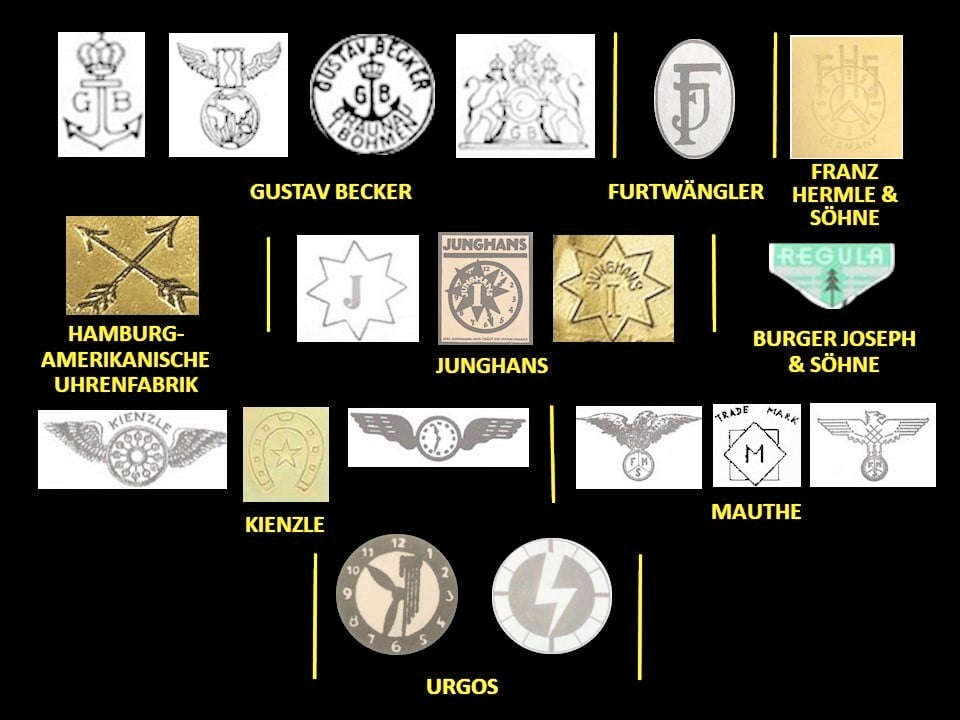
British Trademarks

Austria & Switzerland Trademarks
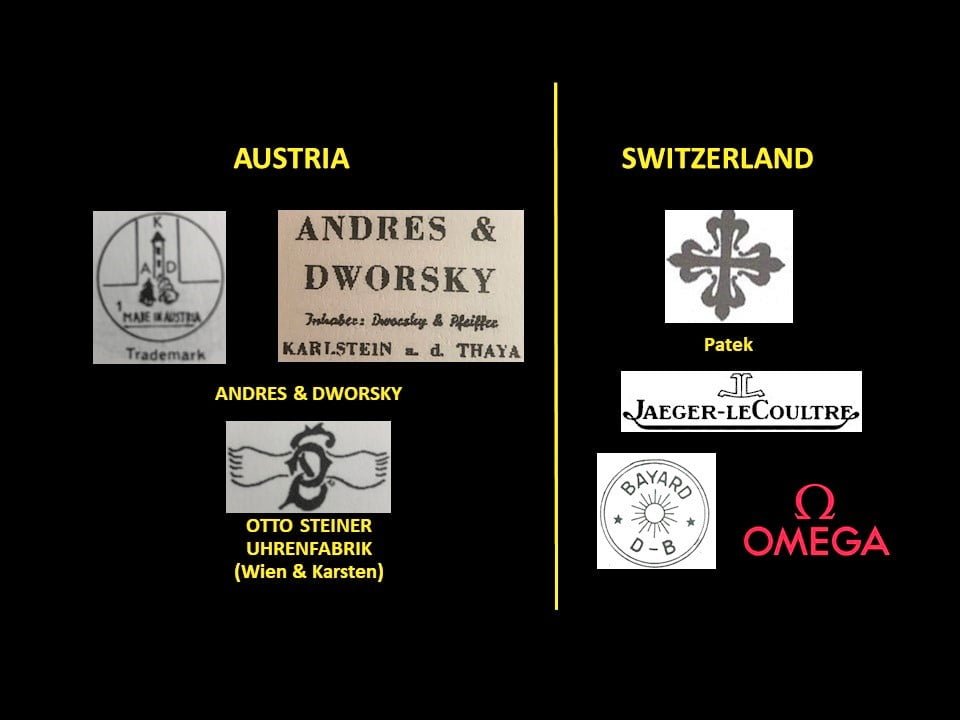
Next: 2.00 – Clock Case Terminology

